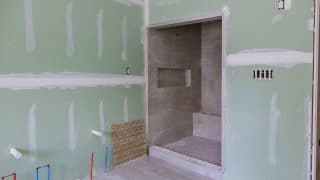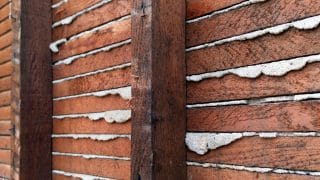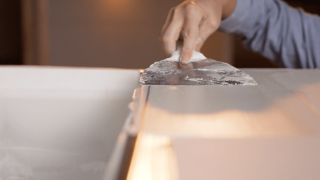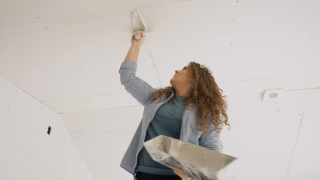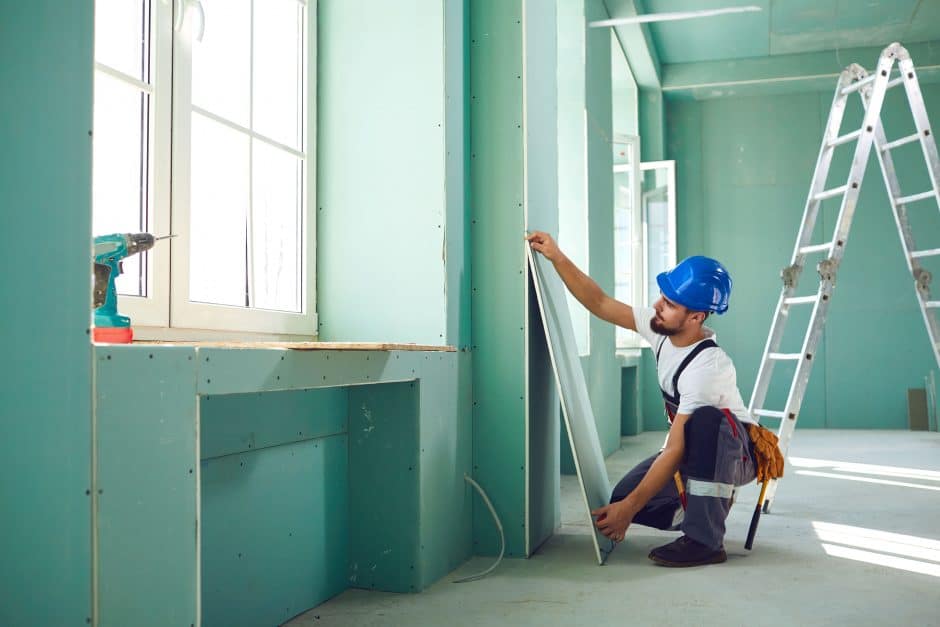
No one likes excessive noise, especially within their home. Whether you have noisy neighbors, or you are a noisy neighbor with a conscience, soundproof drywall can help keep the raucous to a minimum. This building material can prevent sound waves from traveling as effectively as they can through traditional sheetrock.
What is drywall?
Let’s start with the basics. Drywall is a building material made up of sheets of rigid gypsum sandwiched between two layers of paper. Installers use it to cover wall framing, hanging it from the sides of wall studs and joists with nails and screws.
The dimensions for drywall can vary. It comes in thicknesses of ¼-, ⅜-, ½-, and ⅝-inch, and even in thicknesses over 1 inch. Although almost all drywall is 4 feet wide, it comes in 8-, 9-, 10-, 12-, 14-, and 16-foot lengths.
Drywall comes in a few varieties as well, including regular, fire-rated, mold-resistant, and soundproof drywall.
- Regular drywall is the least expensive, and it’s typically found throughout the main living areas within a home.
- Fire-rated drywall is thick and heavy, and it’s most popular in commercial buildings, residential apartment buildings, and office buildings.
- Mold-resistant drywall is better for damp areas like kitchens, bathrooms, and laundry spaces.
- Soundproof drywall consists of multiple layers of gypsum, viscoelastic, and ceramic materials.
What is soundproof drywall?
Unlike traditional drywall panels, which consist of a sheet of gypsum between two layers of paper, soundproof drywall is typically multi-layered. It will usually contain two sheets of rigid gypsum with a sound-deadening barrier between them. This layer usually contains a combination of viscoelastic materials (such as a rubbery green glue or membrane), mass-loaded vinyl, and ceramics. These sound absorbing substances between the layers of gypsum are more effective at preventing the transmission of sound than gypsum alone.
Sound waves travel along rigid, hard surfaces rather easily, so soundproof drywall aims to break the rigid gypsum up with gummy, rubbery, or ceramic layers. As the sound waves pass through the drywall, they reach this layer and vibrate. This causes many of the waves to get trapped inside the drywall rather than passing straight through. For that reason, soundproof drywall is ideal for music studios, entertainment spaces, movie rooms, or common walls between apartments.
How does soundproof drywall compare to other drywall types?
Manufacturers rate their products by giving them STC (Sound Transmission Class) rating. Higher STCs point to the product being more effective at soundproofing. The lower the STC rating, the more sound it will allow to transfer through.
Compared to other products, one layer of soundproof drywall is almost twice as effective at muffling noise as typical drywall. Using the Sound Transmission Class (STC) unit for reference, one layer of ½-inch-thick soundproof drywall has a rating of 52, while the same size layer of typical drywall is 34.
On the basis of cost, however, soundproof drywall is much more expensive than typical drywall. Soundproof drywall costs between $40 and $55 per sheet, whereas typical drywall costs between $12 and $20 per sheet. A room will cost anywhere between 3.5 to 5 times more to cover in soundproof drywall than the regular option.
No one likes excessive noise, especially within their home. Whether you have noisy neighbors, or you are a noisy neighbor with a conscience, soundproof drywall can help keep the raucous to a minimum. This building material can prevent sound waves from traveling as effectively as they can through traditional sheetrock.
What is drywall?
Let’s start with the basics. Drywall is a building material made up of sheets of rigid gypsum sandwiched between two layers of paper. Installers use it to cover wall framing, hanging it from the sides of wall studs and joists with nails and screws.
The dimensions for drywall can vary. It comes in thicknesses of ¼-, ⅜-, ½-, and ⅝-inch, and even in thicknesses over 1 inch. Although almost all drywall is 4 feet wide, it comes in 8-, 9-, 10-, 12-, 14-, and 16-foot lengths.
Drywall comes in a few varieties as well, including regular, fire-rated, mold-resistant, and soundproof drywall.
- Regular drywall is the least expensive, and it’s typically found throughout the main living areas within a home.
- Fire-rated drywall is thick and heavy, and it’s most popular in commercial buildings, residential apartment buildings, and office buildings.
- Mold-resistant drywall is better for damp areas like kitchens, bathrooms, and laundry spaces.
- Soundproof drywall consists of multiple layers of gypsum, viscoelastic, and ceramic materials.
What is soundproof drywall?
Unlike traditional drywall panels, which consist of a sheet of gypsum between two layers of paper, soundproof drywall is typically multi-layered. It will usually contain two sheets of rigid gypsum with a sound-deadening barrier between them. This layer usually contains a combination of viscoelastic materials (such as a rubbery green glue or membrane), mass-loaded vinyl, and ceramics. These sound absorbing substances between the layers of gypsum are more effective at preventing the transmission of sound than gypsum alone.
Sound waves travel along rigid, hard surfaces rather easily, so soundproof drywall aims to break the rigid gypsum up with gummy, rubbery, or ceramic layers. As the sound waves pass through the drywall, they reach this layer and vibrate. This causes many of the waves to get trapped inside the drywall rather than passing straight through. For that reason, soundproof drywall is ideal for music studios, entertainment spaces, movie rooms, or common walls between apartments.
How does soundproof drywall compare to other drywall types?
Manufacturers rate their products by giving them STC (Sound Transmission Class) rating. Higher STCs point to the product being more effective at soundproofing. The lower the STC rating, the more sound it will allow to transfer through.
Compared to other products, one layer of soundproof drywall is almost twice as effective at muffling noise as typical drywall. Using the Sound Transmission Class (STC) unit for reference, one layer of ½-inch-thick soundproof drywall has a rating of 52, while the same size layer of typical drywall is 34.
On the basis of cost, however, soundproof drywall is much more expensive than typical drywall. Soundproof drywall costs between $40 and $55 per sheet, whereas typical drywall costs between $12 and $20 per sheet. A room will cost anywhere between 3.5 to 5 times more to cover in soundproof drywall than the regular option.
How to soundproof a room with drywall
There are actually two ways to soundproof a room using drywall: purchasing and installing soundproof drywall or installing multiple layers of standard drywall.
Method 1: Install soundproof drywall
There isn’t much of a difference between installing soundproof drywall and typical drywall, but these steps should help.
- Measure the wall space and transfer that measurement to a sheet of soundproof drywall. Cut the sheet to length before cutting it to width.
- Butt the backside of the soundproof against the studs. Hold the sheet in place and drive a nail or screw through the drywall and into the studs. Continue driving nails or screws through the soundproof drywall, being sure not to drive the heads of the fastener too deeply into the surface. It should cause a dimple, not a tear.
- Continue around the room, repairing the process. Be sure to butt adjacent sheets tightly against each other for effective soundproofing.
- Finish the wall by applying drywall compound and tape to the joint, sanding, and priming.
The advantage to this method of soundproofing is that it takes about the same amount of time as traditional drywall to install. However, the added layer makes it a bit heavier, so it may take slightly longer than single-layered drywall. It is effective though, offering about an STC 52 rating. Keep in mind that it’s also very expensive compared to traditional drywall products.
Method 2: Double up on traditional drywall
The process of installing two layers of standard drywall doesn’t change much from installing single layers of soundproof or traditional drywall, though it does take twice as long. This option can include installing new drywall over existing drywall or starting fresh with wood studs.
- Measure the wall space and transfer the measurement to a sheet of typical plywood. Cut the sheet to length and then width.
- Butt the backside of the drywall against the studs. While holding the sheet in place, drive screws through the front of the drywall and into the framing. Don’t drive them too deeply or they will rip the drywall.
- Continue around the room, repeating the process. Get the joints as tight as possible to prevent sound transfer.
- This is optional, but stapling a layer of mass-loaded vinyl to the surface of the drywall before moving on to the next step will help absorb sound transmission.
- Install an additional layer of drywall over the first layer, offsetting the seams so they do not overlap.
- Apply drywall joint compound and tape to the joints, sand the compound, prime, and paint.
A double-layer of drywall is actually a bit more effective than a single-layer of soundproof drywall. Also, on a sheet-by-sheet basis, it’s typically around ⅓ or ¼ of the cost. However, the amount of time spent to install a second sheet may be too much of an investment for some folks (if you’re paying for labor, this method will certainly cost more). Also, two layers of drywall will require modifying the outlets, using longer fasteners, and adding more weight to the framing, though it may offer just slightly better soundproofing than one layer of soundproof drywall.
MT Copeland offers video-based online classes that give you a foundation in construction fundamentals with real-world applications, like drywall finishing. Classes include professionally produced videos taught by practicing craftspeople, and supplementary downloads like quizzes, blueprints, and other materials to help you master the skills.

